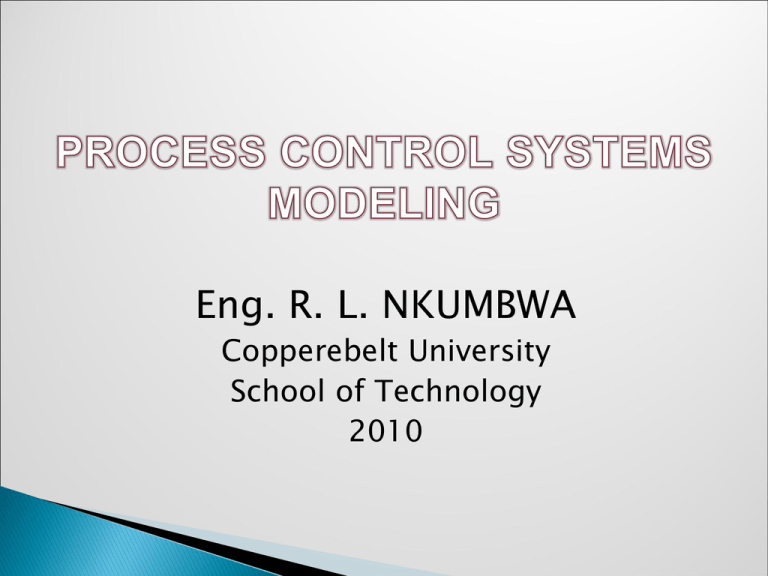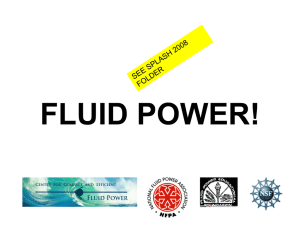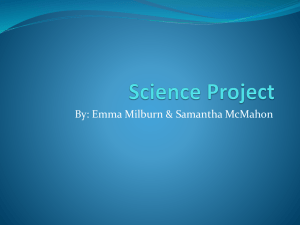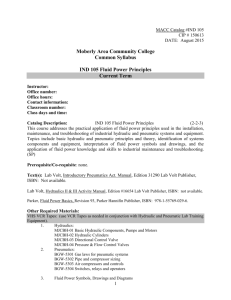Introduction - Greetings from Eng. Nkumbwa
advertisement

Eng. R. L. NKUMBWA Copperebelt University School of Technology 2010 1.0 INTRODUCTION 2.0 TRANSLATIONAL SYSTEMS 2.3 Electrical Systems 3.0 ROTATIONAL SYSTEMS 4.0 HYDRAULIC SYSTEMS 5.0 PNEUMATIC SYSTEMS 6.0 CONCLUSION 7.0 REFERENCES In analyzing and designing of control systems, we need to formulate a mathematical description of the system which is commonly referred to as Modeling. Modeling is the process of obtaining the desired mathematical description of the control system. The basic models of the dynamic physical systems are represented by differential equations. Analysis of a dynamic system requires the ability to predict its control system performance. A model in control system is defined as representation of essential aspects of a system illustrating how it operates. These may include inputs, the system, outputs and feedback. The components of a control system are diverse in nature and may include mechanical and electrical devices. The basic models of the dynamic physical systems are differential equations obtained by the application of the appropriate laws of nature. These equations may be linear or nonlinear depending on the phenomena being modeled. The differential equations are inconvenient for the analysis and design manipulations and so the use of Laplace Transforms which converts the differential equations into algebraic equations is recommended. The algebraic equations may be put in transfer function form, and the system modeled graphically as transfer function block diagram. This Chapter is mostly concerned with differential equations, transfer functions of different physical system such as; Electrical, Hydraulic, Pneumatic, Translational and Rotational systems. This ability and the precision of the results depend on how well the characteristics of each component can be expressed mathematically. The Mechanical Translational Systems basic law is that the sum of forces must be equal to zero. It applies Newton’s law which states that the sum of the applied forces must be equal to the sum of the reactive forces. The basic characterizing elements in a Mechanical Translational System are; The Mass (M), Damper (B) and the Spring (K). The Mass is an inertial element; a force applied to the mass which produces acceleration. The reaction force Fm equals the product of mass and acceleration and is opposite in the direction to the applied force. Fm = -Ma In terms of displacement x, velocity v, and acceleration a, the force equation is given by; F(t) =Ma = M.d2x/dt2 The damping force is proportional to the difference in velocity of two bodies. The reaction damping force fB equals the product of damping B and the relative of the two end of the dashpot. The damping force fB is give by: F(t) = B (v1-v2) = Bv In terms of displacement it is given by: F(t) = B (x1-x2) The spring element, the force equation in accordance with Hooke’s Law is given by: Fk = K (xe-xf) Where xe and xf are the end displacements at e and f respectively. If the end is stationary, the equation is given by: Fk = Kxe x X Reference B K f(t) Figure 1: Mechanical System Rotational Systems are similar to Translational Systems except for the difference that the torque equations are written in place of force equations and that the displacement, velocity and acceleration terms are angular quantities. Meaning that the applied torque is equal to the sum of the reaction torques. Elements of the Rotational System are; 1.Inertia element Tj = Jdω/dt =J.d2ϴ/dt2 = J.D2ϴ 2.Torsional spring element Tk = K (ϴ1 - ϴ2) = Kϴ 3.Damper element TB = B (ω1 – ω2) = Bω θ Disc T Shaft Stiffness Viscous friction coefficient (B) Figure 2: Rotational Mechanical system θ B T(t) K Reference node Figure 3: Electrical Equivalent of Mechanical System J d2θ/dt2 + B dθ/dt + Kθ = T (t) In terms of D operator, JD2θ + BDθ + Kθ = T(t) In Laplace transform the equation will be J s2θ(s) + Bsθ(s) + Kθ(s) = T(s) [J s2 + BS + K] θ(s) = T(s) θ(s)/T(s) = 1/Js2 + Bs + K This equation is a transfer function of the Rotational Mechanical System. Hydraulics is the study of incompressible fluids such as oil and water. Incompressible fluids means that the fluid’s density remains constant despite changes in fluid pressure. The variables for fluid systems are pressure, mass and mass flow rate. P h R A Q Figure 4: Fluid Flow System Where, A is the surface area of the tanks bottom. P is fluid in, Q the fluid out, R is the fluid resistance, and m is mass. If the tank’s side is vertical, the liquid height h is related by; m = ρ Ah In hydraulic actuators as the brake on an automobile. The control flaps of airplanes are actuated by similar hydraulic systems. Hydraulic jacks and lifts are used for raising vehicles in service stations and for lifting heavy loads in the construction and mining industry. For incompressible fluids, conservation of mass is equivalent to conservation of volume, because the fluid density is constant. If qm and q are the mass and the volume flow rates and ρ is the fluid density, the equation is give as: qm = ρ q The conservation of the mass of a container holding mass of fluid m, is given by the following equation; m = qin – qout Where qin is the inflow rate, qout is the outflow rate and fluid mass is related to the container volume V by m=ρV For incompressible fluid ρ is a constant and m = ρV. If q1 and q2 are the total volume inflow and outflow rates, qin = ρ q1 and qout= ρ q2. Substituting this relationships into equation; it gives the following ρ V = ρ q 1 - ρ q2 V = q1 – q2 The working medium in a pneumatic systems or device is a compressible fluid. Industrial Control Systems most frequently use pneumatic to provide forces greater than those available from electrical devices. The response of pneumatic systems is slower than that of hydraulic systems because of the compressibility of the working fluid. The following are the quantities of Pneumatic Systems; Mass, Volume, Pressure and Temperature. This relationship is called the “Perfect Gas Law” which states that, pV = mRgT Where p is the absolute pressure of the gas with volume V, m is the mass, T its absolute temperature, and Rg the gas constant that depends on the particular type of gas. The compressible “flow resistance” of pneumatic components is modeled in the form of the turbulent resistance written here as, Rpq2m = ∆ p Where ∆ p is the pressure drop across the component and Rp is the “pneumatic resistance”. p, q Q P valve container Figure 5: Pneumatic System In this chapter we have defined what Translational, Rotational, Fluid and Pneumatic systems are. There are differences that have been outlined according to mathematical modeling and natural laws Translation uses force equations while Rotational uses torque equations. Hydraulic system is the study of incompressible liquids while Pneumatic uses compressible liquids These equations maybe linear or nonlinear depending on the systems being modeled. Chesmond, C.J, (1990), Basic Control System Technology, J W Arrow Smith Ltd, Bristol, United Kingdom. Nkumbwa, R.L, (2009), Control Systems engineering for 21st Century Engineers and Technologists, Lusaka, Zambia. Parr, E.A, (1996), Control Engineering, Hartnolls Ltd, London, England. Chand, S (1999), Principles of` Control Systems






